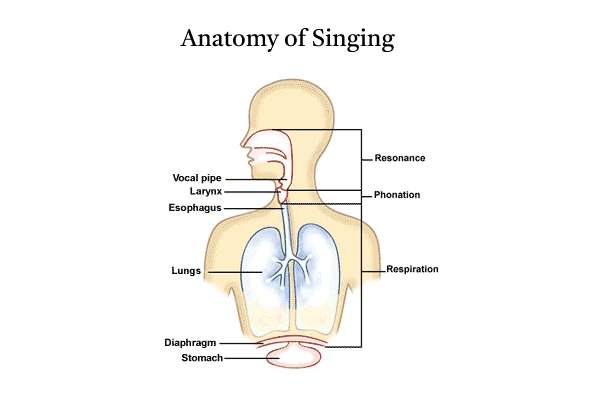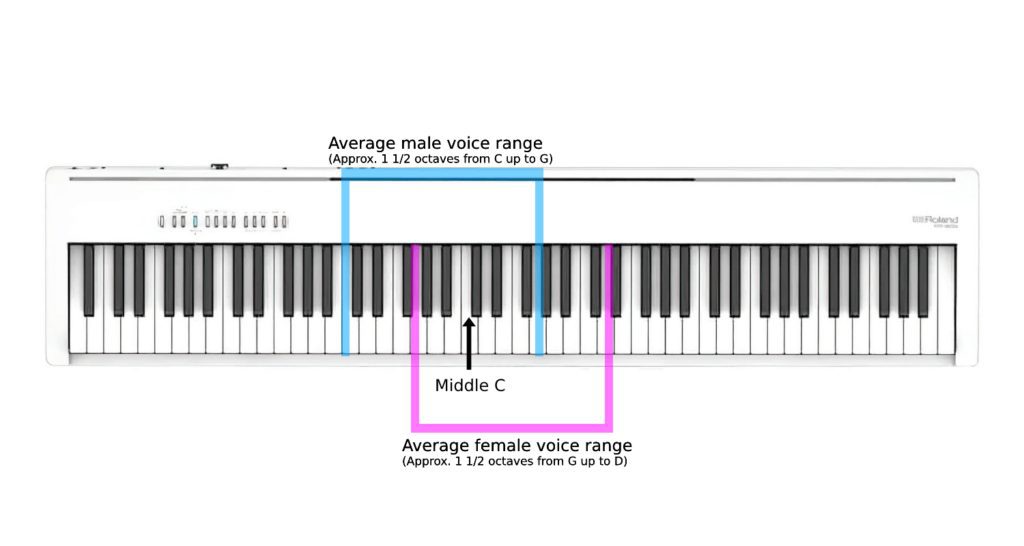In this article, you will learn how to improve your singing. I urge you to forget about what you know, what you think you know or think you don’t know. Be kind to yourself and engage with this material with an open mind.
This article was written by vocalist and singing teacher Myrtle Thomas. Myrtle is a Caribbean-Canadian-born vocalist who has been singing since childhood. She is classically trained and holds a Masters’s degree in Jazz Performance from the renowned Mcgill University.
Singing is not that different from speaking
My objective is to guide each vocalist to a point where singing feels just as natural and comfortable as speaking. This is the overall goal of this article as well as how I approach teaching my students. Keep in ming that, although speaking and singing are related, conscious-purposeful singing would require more energy functionally than speaking.
How the human voice works
While singing is somewhat a more exaggerated extension of speech, like speech it requires the development and coordination of varying intricate skills of their own complex nature. (i.e. oral, verbal, physical, neural, etc.). The following image outlines the main parts of the body that need to be developed to learn how to improve singing.

There are 5 steps to the vocal process:
- Motivation- the mind-body connection. The brain and neurological system sending commands that result in muscular responses informing the vocal process.
- the controlled act of inhaling and exhaling. The muscles and organs used in breathing, functioning in an act of coordination to control the inhalation and release of air as fuel for the voice while singing.
- Phonation- A combination of the larynx, vocal folds, muscle, ligaments, and cartilages that coordinate airflow thru the vocal cords; causing them to vibrate and create a fundamental vocal “buzz” tone.
- Resonation- Cavities like the chest, pharynx, mouth, nose – head, act like a chamber of resonance, of which the vocal tone vibrates and is enhanced.
- Articulation- The use of the speech organs (tongue, jaw, lips, cheeks, teeth, soft and hard palates) in coordination creating a variety of sounds used in human verbal communication. The voice is the only natural ‘musical instrument’ with the ability to shape tone into recognizable speech.
Singing tips for beginners
The following sequence of concepts and execises will help the beginner learn practical tips that can be used today on how to improve your singing. Are you a complete beginnner? Then read 5 Easy Singing Tips for Beginners: A Practical Guide to get started.
Your speech-pitch range
The first thing I work on with my beginner singing students is to find one’s most natural, comfortable, and efficient speech-pitch range. How would you do that? By exploring your speaking range.
This can be done by using our everyday vocal sounds, like yawning, sighing, crying, and light coughing. Although many of us may have acquired speech habits that can hamper this process, ex. Talking at lower pitch levels, these unrestricted sounds are great indicators of your uninhibited natural vocal range.
Finding your most natural, comfortable, and efficient speech-pitch range is an important starting point when learning to sing. Why? Because your singing voice is an extension of your speaking voice. You want to utilize the effortlessness of your speech and vocal expression such as yawning and sighing to tap into where your speaking voice naturally lives and resonates, without tension on the vocal cords and throat.
Everyday vocal sounds like yawning and sighing also help you connect to the parts of your vocal range that you may otherwise think are inaccessible when singing; for example – notes that feel as if they’re too high or too low for you to reach/execute.
However whenever we’re engaged in these common, effortless vocal sounds that lack in throat tension, we don’t usually take notice that we’re executing pitches beyond/outside of our regular comfort zone when in the act of singing.
Be aware that some of us may have developed speech habits over time that are not conducive to vocalizing in an effortless and tensionless manner, (therefore) hampering the process of locating where your voice naturally lives and resonates. [Ex.Talking at a lower pitch level than necessary]
I personally have dealt with that particular issue and continue to work at it with some of the exercises you’ll be introduced to.
Explore the comfortable extremes of your vocal range
Explore your vocal range by sitting at a piano or keyboard. Checking the pitch levels from the piano will give you an audible reference to the sounds you produce within your vocal range. Start with the lower pitches and make your way to the highest pitches. Once again, the unrestricted act of sighing/yawning can help you examine the expanse of your range.

Try to avoid a preconceived perception of how you should sound during these explorative exercises.
Using your everyday speaking voice, talking in a regular fashion, use a piano once again to check the pitch levels of your normal quality voice. Use regular phrases like “How are you?” and “My name is __.”
So, How can playing notes on a pitched instrument, like the piano (for example), and matching it to your speaking voice be helpful in exploring your vocal range?
Well, when we communicate with one another, we not only use body language or words, but we also use the inflections of our speaking voice. Even now as I speak with you, “sometimes the pitch of my voice goes up” and, “sometimes the pitch of my voice goes down.” “Or back and forth.” This is why you can say the same phrase 3 times in a row, altering the inflections of your voice and communicate something completely different each time.
Let me demonstrate this by using a phrase like, “Hey, how are you doing?”
Join along, and see if you can imitate the inflections of my voice.
Record Yourself
Recording yourself while performing these discovery exercises can be quite helpful as it is sometimes challenging to tell if you’re doing what you set out to do in the moment. The replay is a good reference aid.
You can take this a step further by using a higher speaking level while reading a short passage or song lyrics using your normal quality speaking voice. Gradually move to higher pitches, noting where the least stress lies, and where you feel most comfortable; even if it may feel odd or unfamiliar. Don’t push. Keeping note of how the timbre (color) and volume differentiates as you work throughout the lows and highs of your vocal range.
Voice warm-ups for singing
It is important to utilize one’s singing voice daily. It’s also important when doing vocal exercises of any kind, to be aware of why you are doing what you are doing, and to refrain from adopting common exercises without knowing the purpose and impact of the voice. Knowing the purpose of the particular warm exercise will make you more effective and foster awareness of your unique instrument.
Breath support Exercise #1 (Warm-up)
I sometimes like referring to this exercise as the ‘diaphragm stretch’, to visualize the lowering of the diaphragm, the lifting/opening of the rib cage and the filling up of the lungs during the act of inhaling. The term is not exactly accurate because the moment we begin to exhale, the diaphragm reverts back to its concave position and becomes passive in the process of supporting our air supply. It is actually the engagement of our core, ab muscles and back included that helps in creating the resistance we need.

This exercise is a great way to help the singer become aware of the physicality involved in breathing, and build (breath support) endurance.
As singers it’s important to be able to support our air supply and generate the right amount of air pressure to help our vocal cords close completely while singing, creating a smooth tone.
For this exercise, you will….
Give yourself a pulse of 4 beats (this can be done with a metronome) BPM.60
If you don’t have one, you can type ‘metronome’ into your google search engine and the google metronome will pop up. You can then adjust the BPM and get started.
Step #1: breathe in for 4 beats as if sucking in air through a straw.
Step # 2: hold your breath (stay calm in your body, shoulders and chest lowered) for 4 beats
Step #3: exhale/blow on ‘Ssss’ for 4 beats. Keep ab muscles engaged, creating air-pressure
Step #4: Release the leftover air if any once the group of beats is completed.
Step #5: Relax for 10 seconds, then start again.
Gradually you can increase the beats for this exercise. Ex. breath in for 6, hold for 6, exhale for 6, then 8, 10, 12.
Take away: After doing this a couple of times a week, you might find it less challenging to sing without running out of breath.
Vocal Resonators: Chest, Pharynx & Head
We mentioned resonators earlier on although we didn’t go into detail. The three I’ll mention are your chest – which can also be felt in your mouth, the pharynx, and your head. The pharynx is the bridge between the two other resonators. The lip trill which we’ll discuss below is a great exercise to use in stretching out the voice and decreasing tension as the voice transitions from chest to head. The vibrations of the lip trill in particular really help to relax the voice.
You remember when I asked you to try and connect with what you felt in your body while we explored the natural vocal range through yawning and sighing? And, I also asked if you felt any vibrations in your head or chest? What I was alluding to is the resonance your voice uses to shape the tone and magnify volume. There are 3 spaces in the head for the vocal cords sound to resonate in. The chest, the pharynx, and the head.
Put your hand on your chest, and say “Hey!” Do you feel the vibration against your hand? This is called the chest voice. It is a very bold sound. You can also feel the sound resonating and bouncing off the roof of the mouth – your palate.
Now with a lot of gusto/energy, put your hand on the top of your head and say “Goo!” You should feel some light vibration against the palm of your hand. This is the head voice. The sound should be focused, clean and not too airy, if at all. If it’s very airy then it’s probably falsetto.
Lastly we have the Pharynx which resonates at the back of the mouth. The pharynx is the bridge between the chest and head voice. Put your hand on the back of the neck, and create an “Ng” sound. The same sound you would hear in words like “hung” or “sing.”
DEMO
– “Hung” or “sing” w/o releasing the word, keeping the back of the tongue and palate touching.
-Ng like an engine revving up
Take away: These sensations are helpful in discerning what it feels like as you sing notes along the expanse of your vocal range in conjunction with experiencing the fluidity of your air supply.
Resonance is instrumental as well in developing the tone of your voice.
Tips for singing high notes
What I have found most helpful when working with male or female students who are having difficulty singing higher notes, is to once again, take the approach of using ‘everyday expression’ to explore the boundaries, length, and range. Everyday things we do, like yawning and sighing happen without much thought. Most of these actions we perform without any inhibitions.The way the speech pitch of your voice may rise when surprised, or lower when sad is unique to each person and it’s personal to each individual. We never consider or dispute what our yawn or sigh is supposed to sound like.
When trying to reach high notes, I sometimes find it’s helpful to work a song in a sing-songy manner, with lip trills or siren. I often take this approach with my students so that they can “stress-free” experience notes that are accessible and available to them through everyday vocal sounds.
Let’s put these into practise:
High Notes Exercise #1: Sing-Songy Manner
-Try speaking lyrics in a “sing-songy” manner using the inflections that reasonably match the pitch of the melody
Ex. Let’s use “Somewhere Over The Rainbow” as our song
lyrics:
Somewhere over the rainbow
Way up high
There’s a land that I heard of
Once in a lullaby
High Notes Execise #2: The Lip Roll Exercise
This exercise is known as an SOVT (Semi Occluded Vocal Tract) Exercise. This means that the mouth is partially closed while phonating – producing sound. Due to this obstruction, we are creating air pressure.
The 1st occlusion in singing is caused by the resistance created when the vocal cords close on the onset of sound. [DEMO of onset Ex. Ahhhh, Ehhhhh, Ha ]
However, sometimes the vocal folds are having trouble closing properly, and need help to obtain good cord closure. Exercises like the lip roll are useful in creating an additional occlusion, by generating more air pressure to help ensure better vocal cord closure. Less waste of air.
SOVT exercises can help improve the efficiency with which the vocal cords come together to create a clear tone, releasing tension and encouraging relaxation of the throat muscles, and face. They are also helpful in stretching the vocal cords, improving breathing, developing tone quality and vocal resonance.
Additional SOVT exercises:
Tongue Roll
MMMMMMMMMMMM
NNNNNNNNNNNNNN
VVVVVVVVVVVVVVV
ZZZZZZZZZZZZZZZZZ
The Lip roll (also known as lip trill) is a great warm-up you can do before some vigorous singing. It’s also a good cool-down for after. It removes vocal strain off of the vocal cords, putting your throat muscles in a relaxed state. More importantly, it develops cord closure due to the
Some singers may find it easier to execute the tongue roll (demo) instead of the lip roll. That’s okay. You can do the one that works best for you, but don’t give up too soon.
To start off……
Step #1: inhale through the mouth (or nose)
***Just a reminder, it’s very important to feel the engagement of your core (back, abs, torso) as you fill up your lungs.
Step #2: Expel the air. Keep your airflow consistent with relaxed, closed lips while making them roll, without pitch: brrrrrrrr
If you do not provide enough air, you will lose momentum.
Step #3: Next, try to make the lips roll with pitch (sound): brrrrrrrr
Step #4: If you find it difficult to sustain the lip roll, create dimples on each side of your mouth.
This should help relieve tension of the mouth and jaw, making it easier for the lips to roll fluidly. And remember, keep a steady air flow.
Step #5: Now try sliding and gliding from any pitch, high to low, or low to high.
- we can also lip trill on a scale (123454321)
Take away: Lip roll is important. Covers lots of areas, improving breath support
Exercise 2:
-sing/hum a melody on a “lip roll,” or “Mmmm”
Exercise 3:
-sliding/gliding up and down like a siren on “Nnnnnnn”
Take away: By singing higher notes using these everyday speech inflections like in a sing songy manner, or exercising lip trills and sirens, you’re accessing a more natural and effortless place in vocal range.
For more information about developing your high notes have a look at our article: 7 actionable tips for singing high notes.
How to do vibrato singing
What is vibrato? It is not an exact science yet it is generally understood that it’s the body’s reflex to bodily tension oscillating between pitches, measured fluctuation of the voice when it becomes relaxed after sustaining pure tone.
Developing vibrato takes time, practice, and patience. Here are some steps to help you achieve this sought-after singing technique:
- Breath control: Good breath support is crucial for producing vibrato. Practice diaphragmatic breathing by inhaling deeply and allowing your diaphragm to expand, then exhale steadily while maintaining control.
- Relaxation: Tension can inhibit vibrato, so it’s essential to remain relaxed while singing. Focus on keeping your throat, jaw, and tongue relaxed to create an open and free vocal tone.
- Sustain a note: Practice sustaining a comfortable note with a consistent pitch and volume. As you become more proficient, you’ll start to notice the natural oscillation of vibrato in your voice.
- Experiment with pitch: Gently vary the pitch of a sustained note by pushing and releasing your diaphragm. This will help you develop control over the oscillation in your vibrato.
- Use a metronome: Practice singing with a metronome to develop consistency in your vibrato’s speed and rhythm.
- Record yourself: Regularly record your singing to track your progress and identify areas for improvement.
In the end, respect for one’s quality of voice is most important. Some people have a lot, others a moderate amount, and others little to none at all, After much exploration and building of one’s instrument, it should become apparent how their voice responds. I don’t believe vibrato should be an automatic state of being. It can be added or subtracted at will. Taking the view of it being ‘used’ as an expression.
Concluding thoughts
I hope you enjoyed my article on how to improve singing! It was a pleasure to put this together, and layout my voice lesson philosophy. If you are interested in getting touch about setting up singing lessons with me, I would be pleased to hear from you. You can find my profile at this page: Singing lessons Montreal. Simply fill out the form under my name, and I will contact you to setup a lesson. If you’re thinking about finding a singing teacher in Toronto, or a singing teacher in Vancouver, please visit these links added here.


